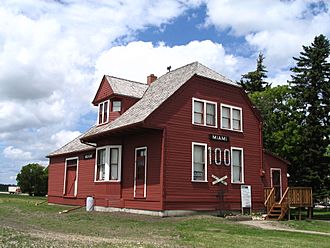Miami Railway Station facts for kids
The Miami Railway Station is an old train station located in Miami, Manitoba, Canada. It was built in 1889 by the Northern Pacific and Manitoba Railway Company. This station is very important because it was named a National Historic Site of Canada in 1976. Today, it is a fun railway museum that opens during the summer months. You can find the museum at the south end of the village, close to where Highway 23 and Letain Street meet.
Building the Railway Station
In the late 1800s, the government of Manitoba wanted more control over its own affairs. They also wanted to expand railway services. Railways were super important for moving goods and people across the country. At the time, the Canadian Pacific Railway (CPR) had a lot of control over train lines in Manitoba.
The government of Manitoba, led by Premier Thomas Greenway, wanted to bring in more railway companies. They talked with different companies, including the US-based Northern Pacific Railway (NPR). In 1888, they made a deal with NPR. This deal meant NPR would build new train lines in Manitoba. One important line would connect Winnipeg to NPR's network in the United States.
The Miami Northern Pacific and Manitoba Railway Station was built in 1889 as part of this railway expansion. About ten years later, in 1899, the station was taken over by William Mackenzie and Donald Mann. They were working to create a huge railway system that would go across Canada. This new system later became known as the Canadian Northern Railway.
What the Station Looks Like
The Miami Railway Station was built to be useful and strong. It is made of wood and was finished in 1889. The building has a tall, sloped roof with a special window section called a dormer. This dormer was used as a lookout point.
One end of the station is connected to a freight shed. This shed was built in 1913 by the Canadian Northern Railway. It was used to store goods that were being shipped by train.
Inside the station, there was a waiting room for passengers. There was also an office for the station agent, who managed train operations. The station master, who was in charge of the station, lived on the upper floor.
A National Historic Site
The Miami Railway Station was used as a working train station until the 1970s. By then, it was part of the Canadian National Railway (CNR) system. In 1976, the station was officially named a National Historic Site of Canada. This means it's a very important place in Canadian history.
In 1999, the CNR sold the train line that went through Miami. The tracks were removed in 2007. Even though trains no longer run here, the station remains.
Over the years, the station has been carefully repaired. Its windows were fixed, and a new foundation was built in 2008. The roof was also repaired in 2015. These repairs help keep the old station in good condition.
This station is special because it's the only one left that was built by the Northern Pacific and Manitoba Railway in this particular style. In 2008, it was also named a Manitoba Municipal Heritage Site. The station is a well-known landmark in the community. It is now one of two museums in Miami and welcomes many visitors each year. The museum teaches people what it was like to be a station master around the year 1900.
Students have even helped to create records of all the items at the museum. This helps to keep track of the station's history and its collection.


